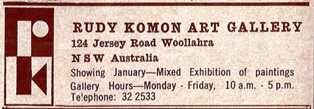Bohemian Paddington and beyond
Bohemian Paddington
Artists began to converge on Paddington in the early 1960s, following the opening of Rudy Komon's Gallery on the corner of Paddington Street and Jersey Road in 1959.1 The gallery was the first of its kind in Paddington and was followed, over the next few years, by Betty O'Neill's gallery The Hungry Horse (the premises were above the restaurant of the same name), Senta Taft's Galleries Primitif in Jersey Road and Melbourne's Gallery A.

Advertisement for the Rudy Komon Art Gallery in the Paddington Journal 1968
The arrival of Kym Bonython in 1967, and his gallery in Victoria Street 'cemented Paddington's reputation as a place to see the best in contemporary Australian art'.2 The property later became home to the advertising agency Mojo3 generally known by the Underwood Street entry, and the former Paddington factory-turned-art-gallery-turned-agency is now the Bonython Cafe.
Paddington 'was also a place where the counterculture [of the 1960s] was beginning to flourish'4 and this period saw the Paddington Town Hall host public meetings and forums on a range of issues including the Vietnam War. In 1962 the cellar at 72 Oxford Street was opened up as “Nestor’s Cellar” and became a meeting place for a range of bohemians, anarchists, hippies and assorted radicals working to undermine the conformity of post-war Australia. In the mid-1960s, the New Left Club, including the write Frank Moorhouse, met there, as did the Sydney Anarchist Group.
The suburb has also been attracting a new wave of residents who saw character and an appealing lifestyle in the terrace houses and lanes of Paddington, rather than a slum. In 1964, a meeting was held to discuss the preservation of Paddington's character and architecture and the Paddington Society was born.
On 24 June 1978, Paddington Town Hall was the location of a public meeting to discuss the international movement for gay rights and the newly-formed Gay Solidarity Group. The day wrapped up with a street parade - Sydney's first Mardi Gras. Ending in violence and arrests, the day became a defining moment in the nation's gay rights history and Mardi Gras (now held in March) is an iconic event in Sydney's calendar.
The Paddington Town Hall continues to be a destination for the residents of Paddington and beyond, to visit the Library, the Cinema, or attend a celebration in the Main Hall. In 2016 it was the venue for an address by then Vice President of the United States, Joe Biden.
1 In 2014, Woollahra Council unveiled a plaque at 124 Jersey Road to commemorate the Rudy Komon.
2 Sandra Hall, 2022
3 In 2021, Woollahra Council unveiled a plaque at 120 1/2 to Alan Morris, one of the co-founders of Mojo
4 Sandra Hall, 2022
Paddington Library - 1977 to the present
Find out more about the modern-day Paddington Library.
Paddington Gallery - 1960's and beyond
Browse through our gallery of Paddington photos from the 1960's all the way through to the present.
- Woollahra Council Plaque Scheme - plaque for Rudy Komon, Art dealer and Patron of the Arts, unveiled at 124 Jersey Road (Cnr of Paddington Street), the site of The Rudy Komon Art Gallery.
- Plaque unveiling for Rudy Komon 2014. The building picture was formerly the Rudy Komon Art Gallery.
- The Windsor Castle, Paddington c1970. Woollahra Libraries Digital Archive PF002071.
- The Hungry Horse Restaurant, No. 72 Windsor Street Paddington. Woollahra Libraries Digital Archive PF005442
- Paddington Town Hall 1974. This image precedes the Town Hall changes which altered the Oxford Street facade. Woollahra Libraries Digital Archive PF005980
- 72 Oxford Street, Paddington. Woollahra Council Field Survey 1982. Woollahra Libraries Digital Archive. In 1962 the cellar at 72 Oxford Street was opened up as “Nestor’s Cellar” and became a meeting place for a range of bohemians, anarchists, hippies and assorted radicals.
- Day of International Gay Solidarity’. Poster, 1978. Artist: Chris Jones. On the afternoon of Saturday 24 June 1978, hundreds of people streamed into Paddington Town Hall for a public meeting to discuss the position of the movement for gay rights internationally and in Australia. Image: Sydney Gay and Lesbian Mardi Gras
- ‘Outrageous Gay Mardi Gras’ Poster, 1980. Artist: Prue Borthwick. “Mardi Gras expanded in 1980, introducing Parade marshals and revising the Parade route – gathering at Bathurst Street, going down George Street, left onto Liverpool Street, up past Hyde Park South and onto Oxford Street, finishing at Paddington Town Hall for the post-Parade Party'. Image and text: Sydney Gay and Lesbian Mardi Gras.
- Paddington Library, Paddington Town Hall 2002. Photographer: Charles Foulsham. Woollahra Libraries Digital Archive PF006344
- Rainbow lights at Paddington Library entrance on Oxford Street, Paddington c2021. Photographer: Corinna Pierce.
- ‘The Librarians’ in the 2022 Sydney Gay and Lesbian Mardi Gras parade at the SCG, March 2022.